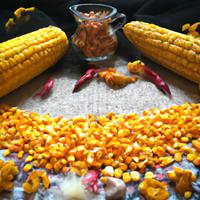
1 serving (28 grams) contains 150 calories, 2.0 grams of protein, 7.0 grams of fat, and 19.0 grams of carbohydrates.

Log this food in SnapCalorie

Nutrition Information
Calories |
750 | ||
|---|---|---|---|
% Daily Value* |
|||
| Total Fat | 35 g | 44% | |
| Saturated Fat | 5 g | 25% | |
| Polyunsaturated Fat | 0 g | ||
| Cholesterol | 0 mg | 0% | |
| Sodium | 750 mg | 32% | |
| Total Carbohydrates | 95.0 g | 34% | |
| Dietary Fiber | 10.0 g | 35% | |
| Sugars | 0 g | ||
| protein | 10.0 g | 20% | |
| Vitamin D | 0 mcg | 0% | |
| Calcium | 10.0 mg | 0% | |
| Iron | 2.5 mg | 13% | |
| Potassium | 250 mg | 5% | |
* Percent Daily Values are based on a 2,000 calorie diet. Your daily values may be higher or lower depending on your calorie needs.
Food Attributes
Source of Calories
About Dry salted corn
Dry salted corn is a crunchy snack made by roasting or drying kernels of corn and seasoning them with salt. This simple preparation has roots in various cultures, particularly Latin American cuisine, where it is often enjoyed as a savory treat or an accompaniment to drinks. Typically, the process involves dehydrating the corn, which concentrates its flavor and creates a satisfying texture. While dry salted corn provides some nutrients found in whole corn, such as fiber and small amounts of vitamins and minerals, its sodium content can be high due to the added salt. This makes it a snack best enjoyed in moderation, especially for individuals watching their sodium intake. Its portability and long shelf life make it an appealing option for on-the-go snacking, but pairing it with other nutrient-rich foods can help create a more balanced diet. It’s a staple of casual and festive occasions alike.



